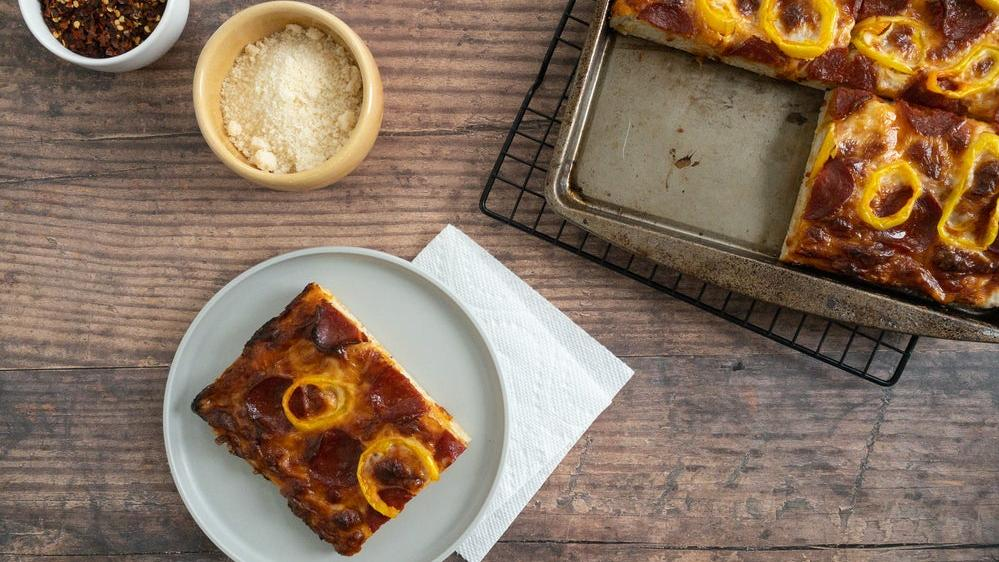The Best Homemade Pizzas Are The Easiest To Make
Pan pizza or grandma-style pies are the best way to make Pizza Night a reality in your kitchen.
When I was a relatively poor and directionless recent college grad, a crummy job and all the expenses of a newly independent life conspired to deny me the joy and thrill of chasing down a good meal. I quickly realized that unless I wanted to subsist on a steady diet of frozen food and canned soup, I was going to have to make the food I craved for myself. And so, like so many others, I turned to the internet and a cheap Italian cookbook.
I don't remember the first thing I made—probably chicken piccata or something—but the recipe that first activated something in my brain was the pizza. The entire process, from the rising of the homemade dough to the clumsy attempt at shaping it, captivated me. I remember pulling it out of the oven, taking a bite and thinking: Holy shit, this actually tastes good. That dawning moment when you realize you can actually make something from scratch yourself and have it turn out well is pretty magical, and for me it happened with pizza. From thin crust to deep dish, pizza has been a constant in my cooking rotation ever since.
In the early days I stuck to Neapolitan or New York facsimiles, the styles I grew up with and still love the most. Over the last few years, though, my pizza making has slowly been taken over by different, thicker styles. From focaccia-like Sicilian pies to the slightly thinner Long Island "grandma" style, sheet pans and cast iron skillets have replaced the baking stones in my oven on pizza night.
The reason for this is totally practical: As I've gotten more experienced at making pizza, I've just realized that most home setups are better suited for pan pizza, a recipe that results in a finished product much closer to its ideal restaurant version than any of the other classic styles I'd been baking. And if you want to level up your homemade pies, you should embrace pan pizza, too.
Why pan pizza is best for home cooks
The most obvious problem with trying to make styles like Neapolitan at home is that they require an incredible level of heat to make properly. No matter how well you prep your dough, my electric oven is not going to be able to match the 900-plus degrees necessary for the charring and "leopard print" crust that define a great traditional pizza. New York–style pizzas don't need quite so much heat, but their size makes them unwieldy unless you've got a pretty big oven and some professional tools at your disposal. None of this means these pizzas aren't worth making at home, but even the best homemade versions of those styles only feel like above-average imitations of what I'm after.
Pan pizzas, on the other hand, are easy to turn out with a regular oven and require only the kitchen gear you probably already have. Recipes almost never require heat above 550 degrees, and depending on the style, you can use a basic sheet pan, a cast iron skillet, or even just a cake pan. Consequently, the pan-style or Sicilian pizzas I've made at home are as crispy, buttery, and satisfying as any I'll get from a takeout order. Truly the home pizza maker's dream.
The other major advantage of pan pizzas is that the process is more streamlined overall. The thicker dough, usually made with some extra fat from oil, is more forgiving to shape and work with. All you need to do is plop it down after the first rise, mold it into the corners of whatever pan you're using, then let it rise a second time to fill out the pan. There are no worries about shaping it too thick or thin, no white-knuckling a rolling pin over a too-sticky dough, no failed attempts to toss the dough in the air or deftly slide the pizza on and off a peel. With a thicker base there are no worries about ending up with a soggy crust if you add a few too many tablespoons of sauce. Outside of a little planning ahead for an overnight rise in the fridge, it's low-stress enough to be an easy weeknight dinner.
There are enough different styles of pan pizza to satisfy almost everyone, too. You can make a fluffy pan pizza that tastes like the best Pizza Hut delivery you've ever gotten, or you can load up the cheese for a Detroit-style pie. Grandma pies were quite literally created by Long Island Italians to be made at home as simply as possible. They are generally thinner, but still have that crispy, bubbly bottom and rich, doughy flavor that make deeper pan pizzas so good. I've personally been a huge fan of sfincione, a style of Sicilian pizza topped with an umami-rich mixture of tomato sauce, anchovies, grated cheese, and bread crumbs.
I still make the occasional thin crust pizza; my love for them hasn't faded, and they'll always be my first choice for takeout. But all those wonderful variations on pan pizza have completely taken over my kitchen. If you currently think of homemade pizza as too much of a hassle, I humbly suggest you give it a shot too.
